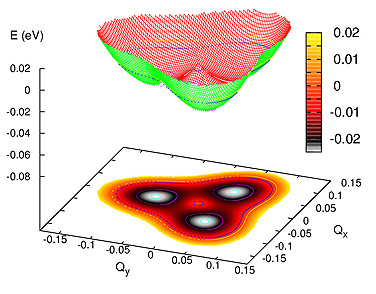News
Research could speed development
of diamond-based quantum computers

Calculated energy surface of the 3E excited state of a diamond nitrogen-vacancy center as a function of distortions, a shape that is often referred to as a “warped Mexican hat.”
-
 Print
Print -
 Comments
Comments
-

“We normally want things to be perfect, but defects are actually very important in terms of electronic applications.”
A UB-led research team has established the presence of a dynamic Jahn-Teller effect in defective diamonds, a finding that will help advance the development of diamond-based systems in such applications as quantum information processing.
“We normally want things to be perfect, but defects are actually very important in terms of electronic applications,” says Peihong Zhang, UB associate professor of physics who led the study. “There are many proposals for the application of defective diamonds, ranging from quantum computing to biological imaging, and our research is one step toward a better understanding of these defect systems.”
The research was published online Sept. 30 in Physical Review Letters.
The findings deal with diamonds whose crystal structure contains a particular defect: a nitrogen atom that sits alongside a vacant space in an otherwise perfect lattice made only of carbon.
At the point of the imperfection—the so-called “nitrogen-vacancy center”—a single electron can jump between different energy states. (The electron rises to a higher, “excited” energy state when it absorbs a photon and falls back to a lower energy state when it emits a photon).
Understanding how the diamond system behaves when the electron rises to an excited state, called a “3E" state, is critical to the success of such proposed applications as quantum computing.
The problem is that at the nitrogen-vacancy center, the 3E state has two orbital components with exactly the same energy—a configuration that is inherently unstable.
In response, the lattice “stabilizes” by rearranging itself. Atoms near the nitrogen-vacancy center move slightly, resulting in a new geometry that has a lower energy and is more stable.
This morphing is known as the Jahn-Teller effect and until recently, the effect’s precise parameters in defective diamonds remained unknown.
Zhang and colleagues from Rensselaer Polytechnic Institute are the first to crack that mystery. Using UB’s Center for Computational Research, the team conducted calculations that reveal how, exactly, the diamond lattice distorts.
Their findings align with experimental results from other research studies and shed light on important topics, such as how long an excited electron at the nitrogen-vacancy center will stay coherently at a higher energy state.
The UB-Rensselaer study was funded by the Department of Energy.

Reader Comments